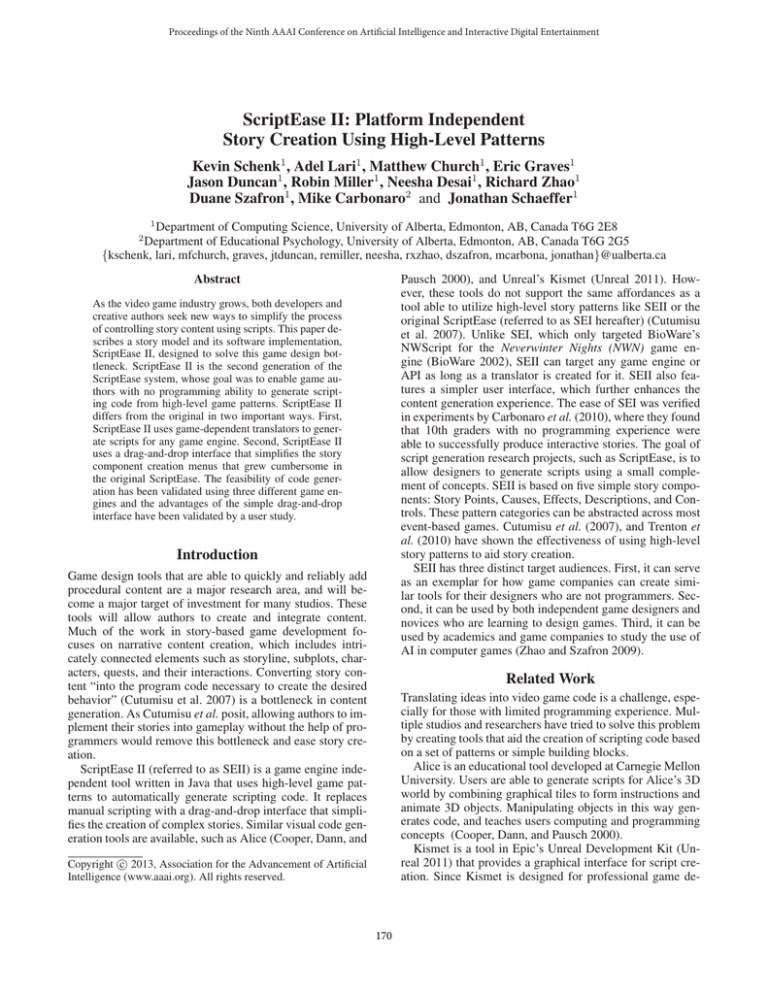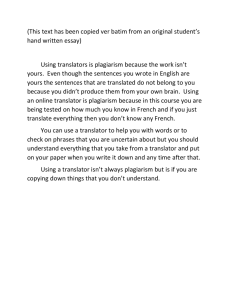
Proceedings of the Ninth AAAI Conference on Artificial Intelligence and Interactive Digital Entertainment
ScriptEase II: Platform Independent
Story Creation Using High-Level Patterns
Kevin Schenk1 , Adel Lari1 , Matthew Church1 , Eric Graves1
Jason Duncan1 , Robin Miller1 , Neesha Desai1 , Richard Zhao1
Duane Szafron1 , Mike Carbonaro2 and Jonathan Schaeffer1
1
Department of Computing Science, University of Alberta, Edmonton, AB, Canada T6G 2E8
Department of Educational Psychology, University of Alberta, Edmonton, AB, Canada T6G 2G5
{kschenk, lari, mfchurch, graves, jtduncan, remiller, neesha, rxzhao, dszafron, mcarbona, jonathan}@ualberta.ca
2
Abstract
Pausch 2000), and Unreal’s Kismet (Unreal 2011). However, these tools do not support the same affordances as a
tool able to utilize high-level story patterns like SEII or the
original ScriptEase (referred to as SEI hereafter) (Cutumisu
et al. 2007). Unlike SEI, which only targeted BioWare’s
NWScript for the Neverwinter Nights (NWN) game engine (BioWare 2002), SEII can target any game engine or
API as long as a translator is created for it. SEII also features a simpler user interface, which further enhances the
content generation experience. The ease of SEI was verified
in experiments by Carbonaro et al. (2010), where they found
that 10th graders with no programming experience were
able to successfully produce interactive stories. The goal of
script generation research projects, such as ScriptEase, is to
allow designers to generate scripts using a small complement of concepts. SEII is based on five simple story components: Story Points, Causes, Effects, Descriptions, and Controls. These pattern categories can be abstracted across most
event-based games. Cutumisu et al. (2007), and Trenton et
al. (2010) have shown the effectiveness of using high-level
story patterns to aid story creation.
SEII has three distinct target audiences. First, it can serve
as an exemplar for how game companies can create similar tools for their designers who are not programmers. Second, it can be used by both independent game designers and
novices who are learning to design games. Third, it can be
used by academics and game companies to study the use of
AI in computer games (Zhao and Szafron 2009).
As the video game industry grows, both developers and
creative authors seek new ways to simplify the process
of controlling story content using scripts. This paper describes a story model and its software implementation,
ScriptEase II, designed to solve this game design bottleneck. ScriptEase II is the second generation of the
ScriptEase system, whose goal was to enable game authors with no programming ability to generate scripting code from high-level game patterns. ScriptEase II
differs from the original in two important ways. First,
ScriptEase II uses game-dependent translators to generate scripts for any game engine. Second, ScriptEase II
uses a drag-and-drop interface that simplifies the story
component creation menus that grew cumbersome in
the original ScriptEase. The feasibility of code generation has been validated using three different game engines and the advantages of the simple drag-and-drop
interface have been validated by a user study.
Introduction
Game design tools that are able to quickly and reliably add
procedural content are a major research area, and will become a major target of investment for many studios. These
tools will allow authors to create and integrate content.
Much of the work in story-based game development focuses on narrative content creation, which includes intricately connected elements such as storyline, subplots, characters, quests, and their interactions. Converting story content “into the program code necessary to create the desired
behavior” (Cutumisu et al. 2007) is a bottleneck in content
generation. As Cutumisu et al. posit, allowing authors to implement their stories into gameplay without the help of programmers would remove this bottleneck and ease story creation.
ScriptEase II (referred to as SEII) is a game engine independent tool written in Java that uses high-level game patterns to automatically generate scripting code. It replaces
manual scripting with a drag-and-drop interface that simplifies the creation of complex stories. Similar visual code generation tools are available, such as Alice (Cooper, Dann, and
Related Work
Translating ideas into video game code is a challenge, especially for those with limited programming experience. Multiple studios and researchers have tried to solve this problem
by creating tools that aid the creation of scripting code based
on a set of patterns or simple building blocks.
Alice is an educational tool developed at Carnegie Mellon
University. Users are able to generate scripts for Alice’s 3D
world by combining graphical tiles to form instructions and
animate 3D objects. Manipulating objects in this way generates code, and teaches users computing and programming
concepts (Cooper, Dann, and Pausch 2000).
Kismet is a tool in Epic’s Unreal Development Kit (Unreal 2011) that provides a graphical interface for script creation. Since Kismet is designed for professional game de-
c 2013, Association for the Advancement of Artificial
Copyright Intelligence (www.aaai.org). All rights reserved.
170
velopment rather than being an educational tool, it allows
certain affordances that Alice does not. Users are able to
connect various actions and conditions to create sequences.
They then use an annotative flow chart to select appropriate behaviors that occur when an event is fired on an object.
While Kismet allows for some complex interaction in its environments, the sequences are generally not reusable and the
low level focus makes it difficult to learn and use (Cutumisu
et al. 2007). Additionally, Kismet is proprietary software and
thus limited to the Unreal Development Kit.
Other examples include MIT’s Scratch (Resnick et
al. 2009), WeQuest (Macvean et al. 2011), Skorupski
and Mateas’ Story Canvas (2010), Pizzi and Cavazza’s
Interactive Storytelling tool (2008) and Microsoft’s
Kodu (MacLaurin 2009) plus extensions (Fristoe et al.
2011). Each tool is tied to a single specific game engine.
Whereas SEI can only create stories for BioWare’s Neverwinter Nights engine, SEII can target any game engine or
API for which a translator is built.
In SEI, stories are created using patterns selected from a
set of menus. To create the story in SEII, cause-effect story
components are dragged from the Library pane on the top
left of the screen to the Story Point pane on the bottom
right. Objects from the game-object pane on the bottom left
are then dragged onto the story components to contextualize
them for the story being told. Since translators may contain
over 100 story components in their library, SEII also provides a search filter to further simplify finding and selecting
appropriate cause-effect story components.
ScriptEase II Story Model and Story Creation
SEII generates scripting code and attaches the scripts to
game objects. We refer to the entire collection of scripts attached to a game as a story and the user as a story author.
SEII aims to be accessible to a larger demographic, with
users as young as elementary school students. Carbonaro et
al. (2010) found that the use of high-level patterns alone allowed tenth graders with no computing skills to make fairly
intricate stories without programming or scripting. As stated
by Trenton et al. (2010), “game patterns that describe basic
game interactions are usable by the general population without the knowledge of computer scripting.”
From Original ScriptEase to ScriptEase II
The Story Graph and Story Points
In our model, a story is represented as a directed acyclic
graph of story points, as shown by the simple illustrative
pirate story in Figure 2. In real game stories, there are potentially hundreds or thousands of story points. Each story
point corresponds to an important event that may occur during the story. As most story-based video games are eventbased, events provide a simple and effective way to decompose a story into story points. In our model, each event consists of a cause and its associated effects that are based on a
library of commonly occurring tropes within video games.
For example,
Cause: when a lever is pulled
Effects: a door opens
a sound is played
When a story starts, the Start story point is active. Until
the story ends, one or more story points is active. A story
point is visited when it is active and its cause occurs or has
occurred. For example, in Figure 3, when the story starts, the
Start story point is active, but it is not visited until the player
actually talks to the Captain and reaches a particular dialogue line. When a story point is visited it can either succeed,
fail or neither (mechanism explained later). If it succeeds,
then all immediate successor story points become active (except for merge story points, also explained later). The succeeded (or failed) story point is deactivated. If neither happens, the story point remains active and can be visited again
later. For example, if the Start story point in Figure 2 succeeds then it is deactivated and three story points following
it are activated: Parrot, Rum and Kill. When a story point’s
success activates multiple story points, we say the story has
Figure 1: A simple story pattern in the original ScriptEase.
The two main goals of SEI were a) to have all authoring
done with high-level story patterns and b) to present the authors with a natural description of the story they wished to
create (Cutumisu et al. 2007). SEII retains these goals, but
implements them with a drag-and-drop interface as opposed
to SEI’s menu-driven approach. When comparing a story
created with SEI from Figure 1 with an equivalent story created in SEII from Figure 3, it can be seen that SEII provides
the same natural language descriptions but with a more visual interface.
While SEI uses a text-based view of a story in an indented tree-like structure, SEII uses a graph structure to
show the story within the context of the game. Each story
graph node (called a Story Point) contains related causeeffect story components. Since a story in a non-linear storybased game is analogous to a decision graph (Trenton et al.
2010), SEII provides a view that is more visually consistent with the story model. SEII is also game independent.
171
tool palette on the left edge of this pane can be used to edit
the story graph, by adding and deleting arcs and story points.
Each story uses some scene files that were created by designers using a game-dependent tool, such as the NWN Aurora
Toolset or the Unity editor. Each scene file contains game
objects, some of which may have been originally created using other tools such as 3ds Max or Maya. Figure 3 uses a
NWN scene file (called a module). The game objects are
shown in the game object pane (lower left). Examples are a
Placeable called Armoire and a Door called Captain’s Quarters Door.
If a story point is selected in the story pane, its contents
are shown in the story point pane (lower right). Each story
point should contain one or more causes. In Figure 3, the
“(SP) Start − Talk to the Captain” story point contains the
cause “When (DL) <A’right, be right back.> is reached”.
Each cause includes a <Subject>, which is used to specify the game object for which the cause must occur. In Figure 3, the <Subject> slot is filled with a dialogue line object
(DL). When this particular dialogue line of Captain Silver is
reached in a conversation, the cause occurs. To place this
cause in the story point, the author first selected the story
point in the story pane. Next, the author dragged the cause
“When (DL) <Subject> is reached” from the library pane
(upper left) into the story point pane (lower right). Finally,
the author dragged the “(DL) A’right, be right back” dialogue line object from the game object pane (lower left) onto
the <Subject> slot of the cause.
Slots, like the<Subject> one, appear in many story components and must be filled, usually by game objects. All slots
specify the types of game objects that are allowed, such as
dialogue lines (DL), creatures (C), text (T), or lists (Li). The
circles on the left side of a slot indicate the allowed types.
A single slot may allow game objects of multiple types. In
Figure 3, the <object> being unlocked could be either be a
door (D) or a placeable (P).
Each cause can contain effects, descriptions and controls.
In Figure 3, an “Animate subject to (Li) [Animation]” effect
was dragged from the library pane into the cause. The animation “Looping Talk Normal” was selected from the [Animation] list of the effect.
In addition to game objects, the author can also use predefined implicit objects. Consider the cause: “When (D)(P)
<subject> is closed by (C) Last Closer”, which is highlighted in the Library pane (upper left in Figure 3). If this
cause was dragged into the story point pane, the “(C) Last
Closer” implicit object could be used for any effect that requires a Creature (C). An author can apply effects to the specific creature that closed the door, even though this creature
is not preset but dynamically determined during gameplay.
There are other situations where an author cannot identify
a particular game object before the game is played, such as
the nearest object to the player character, or whether a particular story point is currently active. SEII solves this problem by using descriptions. A description describes a game
object dynamically and allows the author to refer to the described object with a label. Figure 3 shows an example description, labeled “Is Active”, which represents whether the
“(SP) Start − Talk to the Captain” story point is active or not.
branched. Branching is common in interactive games since
the player can follow multiple story arcs concurrently.
If a cause occurs and its story point is not active then the
story point is not considered visited. For example, imagine
a quest that is initiated after the Captain asks the player to
fetch his parrot. If the player fetches the parrot before talking
to the Captain, the Parrot story point is not visited and does
not succeed or fail at that time. This is important since it is
common to have a quest journal entry appear in a player’s
journal when a story point succeeds and it would be awkward if a quest entry appeared before a quest actually started.
What happens if the player fetches the parrot and then talks
to the Captain? In this case, when the player talks to the Captain, the Start story point would succeed and the Parrot story
point would be activated, as normal. However, there are two
possible semantics for out of order actions. We can either
remember that the cause has occurred and immediately succeed the Parrot story point or we can wait until the cause
occurs again. With the second semantics, the player would
have to fetch the parrot again. We support the first semantics
since it is the most common one. Using the second semantics or allowing the author to select the semantics would be
an easy change to SEII.
It is often possible to follow multiple branches in a story
concurrently. For example, in the pirate story, the player may
decide to fetch the captain’s parrot and then fetch the captain’s rum. Another alternative is to fetch the captain’s parrot and then kill the captain. When a story branches, the
branches often rejoin at a merge story point that has more
than one predecessor. For example, in Figure 2, the Return
story point is a merge story point with two predecessors,
Parrot and Rum. Sometimes an author wants a merge story
point to become active when any one of its predecessor story
points succeeds and sometimes an author wants all predecessor story points to succeed before a story point becomes
active. In SEII the author can select how many predecessors
must succeed before a merge story point becomes active. For
example, in Figure 2, both Parrot and Rum must succeed
since there is a “2” in the merge story point labeled Return.
If the author required the player to fetch either the Parrot
or the Rum, the author would use a “1”. It is possible to
express any complex requirement on particular story points
using this mechanism. For example, if the author wants all
three from a particular set or both from another set of two
then one intermediate story point is created using a “3” to
merge the three and another story point with a “2” is used to
merge the two and then a final story point is used to merge
the two intermediate story points with a “1”.
Creating game content that may not be reached in a single play-through can be expensive for designers. To reduce
costs, this extra content is often not implemented by game
studios. Lowering the cost of creating branching content allows authors to build more complex stories and increase replay value.
Story Components and Game Objects
Figure 3 is a screenshot from SEII showing a story called
Treasure Island. This is the same story as in Figure 2. The
story graph is shown in the story pane (upper right). The
172
Figure 2: A story involving a pirate and the various story points that need to be reached in order to complete it.
Figure 3: Part of a ScriptEase II story. The top right pane contains the story graph with multiple story points. The bottom right
pane contains a single cause with multiple effects for the selected story point.
This description has two possible values, “Yes” and “No”.
Description labels can be dragged to slots like game objects
or implicit objects. In general, descriptions can be dragged
from the library pane into the story pane and then the slots
can be filled with objects.
Game stories are interactive so the story depends on
player choices. SEII provides a control called a question,
which can be used to control the story. Each question has
two sections, “Yes” and “No”, that can each contain effects,
descriptions and controls that are performed based on the
dynamically computed answer to the question. For example,
in Figure 3, the “Set the (D) Captain’s Quarters Door to (Li)
Unlocked” effect and the “Succeed (SP) Start − Talk to the
Captain” effect will occur if the label “Is Active” has value
173
fact that this was the first translator written for SEII. Conversely, the Unity translator was generating code after just
two weeks of development, because its game file format is
written in plain text YAML code and it was the third translator written. Similarly, the programmer’s experience with
scripting code determines how long populating the API dictionary takes. The API dictionary for the Unity translator
was populated using a graphical Library Editor. Rigorous
testing of translators by multiple authors and by creating
multiple games before publishing adds to development time.
“Yes” and won’t occur if the value is “No”. It is very common for authors to want different effects to occur based on
whether a story point is active or inactive. Because of this,
when a clause is dragged from the library pane to the story
point, SEII automatically adds the “Is Active” description
for the current story point and adds the “Is Active?” question. The author can simply delete these components if they
are not required.
There are currently two other controls in SEII. The first
delays the performance of its contents for a certain time (e.g.
wait four seconds and then spawn a creature) and the second
repeats its contents a certain number of times (e.g. spawn
four creature).
Unity Translator
Code Generation
To maintain game independence, SEII uses pluggable game
translators, where each translator generates scripting code
for a particular game engine. Each translator has three components. The first is a set of XML files that define the game
engine API. The second is an XML file that specifies the
grammar of the scripting language. The third is the implementation of an interface for reading and writing game objects from game-specific scene files. A translator creation
tool is available to help developers build translators.
SEII’s game independence was proven by creating three
translators. The first was for the Neverwinter Nights game
engine. This translator was used successfully in an undergraduate game design course. A SEII translator was also created to generate C++ code for controlling the scoring system
of a physical pinball machine which had a C++ API (Wong
et al. 2010). Finally, a translator for the Unity 4 game engine (Unity Technologies 2013) was created. We have used
the Unity translator to author a 2D space shooter and a simple 3D RPG.
Figure 4: Two causes created with the Unity Translator.
Many events in Unity occur by checking conditions in
methods that are updated at different times, such as during
each frame of the game or each physics time step. If causes
were built this way, there would only be a few causes and
users would need to write a description and a question every time they are used. Although the translator provides this
functionality, we have also included high level causes that
simplify the game authoring process. For example, instead
of creating a question to determine if the mouse has been
clicked in the “when game frame updates” cause, the user
can use a “when mouse is clicked” cause. This approach
allows authors to create stories more quickly, while still
supporting the flexibility of Unity’s API for power users.
Figure 4 shows two causes form a simple Unity story in
ScriptEase. It uses a more abstract “when mouse is clicked”
cause and also uses an A* pathfinding library in addition to
the main Unity library.
Translator Creation
Translator Format
A SEII translator requires a Java interface between the three
translator components and SEII. The three components are:
an API dictionary serving as a library of story components,
a language dictionary for the syntax of generated code, and
an implementation of the story system. The interface extends a class with specific methods. This interface parses the
game file so SEII can find game objects and attach generated
scripts to them. The API dictionary contains definitions of
the story components and the code to be generated for them.
The language dictionary defines the format of the types of
story components. Creating a translator will require a programmer to write an implementation of the story system in
native game code that can then be used by the effects to control the flow of the story.
Evaluating ScriptEase II
Development Time
In 2013, SEII was used by undergraduate students in a multidisciplinary game design course (Sturtevant et al. 2008),
where two thirds of the students have no programming experience. In groups of six, students spend the semester making a fully functional story-based computer game with 3Dgraphics, sound and music, using the Neverwinter Nights
The time required to write a translator depends on the complexity and documentation of the game file format, and the
programmer’s experience with the game scripting code. For
example, the Neverwinter Nights translator took months to
develop due to the complex format of the scene files and the
174
Easy to Learn
Intuitive
Easy to Organize
Easy to use Definitions/
Descriptions
Easy to use Multi-Conditions/
Questions
Easy to use Journals
Easy to use Dialogue
SEI
3.0
2.5
2.6
SEII
3.4
2.8
3.0
d-value
0.65
0.57
0.65
effect
moderate
moderate
moderate
2.5
2.9
0.62
moderate
2.5
2.5
3.4
2.9
3.0
2.7
0.52
0.73
1.02
moderate
moderate
large
Table 1: Survey results comparing the original ScriptEase and ScriptEase II using Cohen’s d-Value (1988) where moderate is
0.5 − 0.8 and large is > 0.8 with n=10.
could be obtained by customizing the translator to include
new causes, effects and other story components. However,
we do not yet have simple tools available for editing translators. Our next steps will include creating tools to allow
users to edit the translator and examining the ability for very
young authors (middle school children) to create games in
SEII.
game engine at the University of Alberta. In the past, students were taught how to use SEI. This time, students were
allowed to choose between learning SEI and SEII.
After completing tutorials on either SEI or SEII, we asked
the students to complete a survey. We collected 10 completed surveys for SEI and 10 for SEII. The students were
asked to rate the system they chose to use based on a number
of attributes using Likert scales. Generally, each category
had four possible answers to choose from, usually ranging
from very difficult to very easy. We purposely left out a neutral to force an evaluation. The results were translated into a
numeric value from one to four, with one corresponding to
very difficult and four to very easy.
As we had only 10 results for each, we decided to look
at the overall effect size instead of T-Tests (Kelley and
Preacher 2012). An effect size is a descriptive statistic that
conveys the estimated magnitude of a relationship. The results are shown in Table 1.
In most categories, SEII has a moderate effect size over
SEI (easy to learn, intuitive, easy to organize, using descriptions, using questions, using journals). The moderate effect
size for descriptions over definitions was expected, since our
descriptions are based on earlier work by Desai and Szafron
(2011) where descriptions were found to be easier to understand. It was also interesting that participants appeared to
prefer our journal system to the SEII method, as we initially
thought the new journal design might be more difficult to
grasp. We also asked three questions where the effect sizes
were small (d-value<0.5): enjoyability, ease of controlling
game objects, ease of referencing game objects.
The one large effect involved dialogues, where SEI performed better than SEII. We believe the reason for this is
that the interface for interacting with dialogues in SEI is
modelled directly on the NWN Aurora Toolset which is sold
with the official Neverwinter Nights game. In SEII, the dialogue lines are instead shown in the same game object pane
as the rest of the game objects. This result has inspired us to
construct a game-independent visual dialogue tool for SEII.
The improvements and changes in SEII have made the
ScriptEase system easier to use. However, not all students in
the course used ScriptEase I or II for their final game stories.
The most common reason for not using ScriptEase was to
access the greater expressive power that native scripting languages support. Many of the advantages of direct scripting
Conclusion
SEII and its story model provide a solution to an issue faced
by both game studios and amateur game authors: how to
proceed from designing the story to implementing it. SEII
is built using high-level game patterns that support the creation of intricate stories. Non-programmers can use these
patterns to easily create interactive games. SEII’s gameindependence means it can be adapted to any game engine
by creating a translator for it. Aside from story creation,
SEII is also used as a research tool for topics such as education and commercial game-related AI. It can be downloaded from http://cs.ualberta.ca/%7Escript/. Future work
includes implementing behaviour patterns that support more
intelligent interactions between non-player characters, story
groups for further organization of the story graph, and the
creation of translators for other game engines.
Acknowledgements
This research was supported by GRAND NCE, NSERC,
iCORE, and Alberta Innovates Technology Futures. Thanks
to the anonymous reviewers for their suggestions. Thanks to
the entire ScriptEase and ScriptEase II research and development teams.
References
BioWare. 2002. Neverwinter Nights. [Video Game].
Carbonaro, M.; Szafron, D.; Cutumisu, M.; and Schaeffer,
J. 2010. Computer-game construction: A gender-neutral
attractor to computing science. Computers & Education
55(3):1098–1111.
Cohen, J. 1988. Statistical power analysis for the behavioral
sciencies. Routledge.
Cooper, S.; Dann, W.; and Pausch, R. 2000. Alice: a 3-d
tool for introductory programming concepts. In Journal of
175
Computing Sciences in Colleges, volume 15, 107–116. Consortium for Computing Sciences in Colleges.
Cutumisu, M.; Onuczko, C.; McNaughton, M.; Roy, T.;
Schaeffer, J.; Schumacher, A.; Siegel, J.; Szafron, D.;
Waugh, K.; Carbonaro, M.; et al. 2007. Scriptease: A generative/adaptive programming paradigm for game scripting.
Science of Computer Programming 67(1):32–58.
Desai, N., and Szafron, D. 2011. Descriptions: a viable
choice for video game authors. In Proceedings of the 6th
International Conference on Foundations of Digital Games,
268–270. ACM.
Fristoe, T.; Denner, J.; MacLaurin, M.; Mateas, M.; and
Wardrip-Fruin, N. 2011. Say it with systems: expanding
kodu’s expressive power through gender-inclusive mechanics. In Proceedings of the 6th International Conference on
Foundations of Digital Games, 227–234. ACM.
Kelley, K., and Preacher, K. J. 2012. On effect size. Psychological Methods 17 (2):137–152.
MacLaurin, M. 2009. Kodu: end-user programming and
design for games. In Proceedings of the 4th International
Conference on Foundations of Digital Games, 2. ACM.
Macvean, A.; Hajarnis, S.; Headrick, B.; Ferguson, A.;
Barve, C.; Karnik, D.; and Riedl, M. O. 2011. Wequest:
scalable alternate reality games through end-user content authoring. In Proceedings of the 8th International Conference
on Advances in Computer Entertainment Technology, 22.
ACM.
Pizzi, D., and Cavazza, M. 2008. From debugging to authoring: Adapting productivity tools to narrative content description. In Interactive Storytelling. Springer. 285–296.
Resnick, M.; Maloney, J.; Monroy-Hernández, A.; Rusk, N.;
Eastmond, E.; Brennan, K.; Millner, A.; Rosenbaum, E.; Silver, J.; Silverman, B.; et al. 2009. Scratch: programming for
all. Communications of the ACM 52(11):60–67.
Skorupski, J., and Mateas, M. 2010. Novice-friendly authoring of plan-based interactive storyboards. In AIIDE.
Sturtevant, N. R.; Hoover, H. J.; Schaeffer, J.; Gouglas, S.;
Bowling, M. H.; Southey, F.; Bouchard, M.; and Zabaneh, G.
2008. Multidisciplinary students and instructors: a secondyear games course. In ACM SIGCSE Bulletin, volume 40,
383–387. ACM.
Trenton, M.; Szafron, D.; Friesen, J.; and Onuczko, C. 2010.
Quest patterns for story-based computer games. In Proceedings of the Sixth Artificial Intelligence and Interactive Digital Entertainment Conference, 11–13.
Unity Technologies. 2013. Unity. [Game Engine].
Unreal. 2011. Kismet visual scripting. [Video Game].
Wong, D.; Earl, D.; Zyda, F.; Zink, R.; Koenig, S.; Pan, A.;
Shlosberg, S.; Singh, J.; and Sturtevant, N. 2010. Implementing games on pinball machines. In Proceedings of the
Fifth International Conference on the Foundations of Digital
Games, 240–247. ACM.
Zhao, R., and Szafron, D. 2009. Learning character behaviors using agent modeling in games. In 5th Annual Artificial
Intelligence and Interactive Digital Entertainment Conference (AIIDE-09), 179–185.
176








